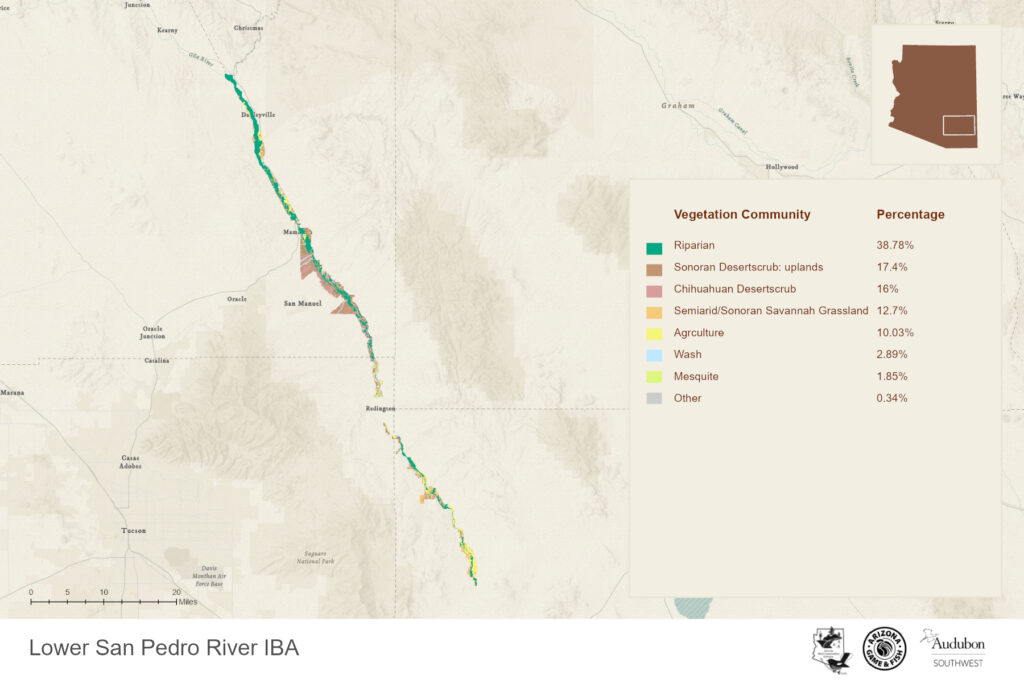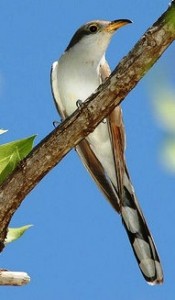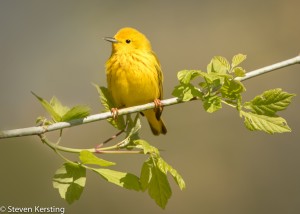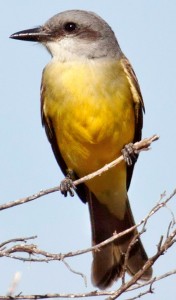Global IBA for Bell’s Vireo
Continental IBA for Abert’s Towhee
Conservation Stewards: Tucson Audubon Society, The Nature Conservancy, Cascabel Working Group, Redington and Winkleman NRCDs, Lower San Pedro Watershed Alliance, Lower San Pedro Collaborative
Size: 51.2 square miles, 32,762 acres
Identified: 01/2007, Global on 01/2008. Recognized: 02/2008
Visiting the IBA: Most of the lands in this IBA are privately owned with no public access. BLM land at San Manuel Crossing and private land at Dudleyville Crossing are open for walk in public. The privately owned 7B Ranch is located east of the town of Mammoth and has a recently developed walking trail at Copper Canyon Road.
Ownership and Management: Arizona Game and Fish Department, BLM, Bureau of Reclamation, Salt River Project, The Nature Conservancy, Pima County, Private
Site Description: The IBA is over 60 miles in length and begins at the southern boundary of 3 Links Farm in Cochise County and follows the San Pedro river downstream north to the confluence with the Gila River at the town of Winkleman. A free-flowing river, the San Pedro has well developed cottonwood-willow gallery forest riparian habitat interspersed with old growth honey mesquite (Prosopis juliflora) woodlands known as bosques. The largest intact mesquite bosque community in Arizona is located on 14 miles of the San Pedro River beginning south of the community of San Manuel and ending north of the community of Mammoth. The majority of the land is privately owned and only select properties in public ownership or under conservation easement and management are specifically included in the IBA.
Birds: The importance of the lower San Pedro River for the recovery of the Southwestern Willow Flycatcher contributed to its designation as critical habitat for the species. Species of special conservation status and interest that use the habitats within this IBA include:
Year-round: American Kestrel, Ladder-backed & Gila Woodpeckers, Northern Flicker, Gilded Flicker, Black Phoebe, Say’s Phoebe, Bewick’s Wren, Abert’s Towhee, and Song Sparrow.
Breeding: Common Black-Hawk, Gray Hawk, Zone-tailed Hawk, Mississippi Kite, White-tailed Kite, Elf Owl, Yellow-billed Cuckoo, Western Purple Martin, SW Willow Flycatcher, Vermilion Flycatcher, Northern Beardless Tyrannulet, Thick-billed Kingbird, Tropical Kingbird, Brown-crested Flycatcher, Ash-throated Flycatcher, Bell’s Vireo, Lucy’s Warbler, Yellow Warbler, Summer Tanager Bullock’s Oriole Hooded Oriole
Migration: Willow Flycatcher, Olive-sided Flycatcher, Warbling Vireo, Yellow-rumped Warbler (Audubon’s), MacGillivray’s Warbler, Virginia’s Warbler, Black-throated Gray Warbler, Nashville Warbler, and Wilson’s Warbler, Black-headed Grosbeak, Western Tanager, and Lazuli Bunting.
Winter: Belted Kingfisher, and Red-naped Sapsucker.
eBird focus species: Breeding season: Gray Hawk, Mississippi Kite, Elf Owl, Yellow-billed Cuckoo, Bell’s Vireo, Lucy’s Warbler, and Abert’s Towhee.
Conservation Concerns: Irrigation water diversions, development, wild fire, OHV use in riparian areas, wood cutting, invasive plants (salt cedar). Strategies: Conservation partnerships among landowners
Extended Site Description of this very complex Important Bird Area:
Portions of the IBA within Cochise County include the Three Links Farm consisting of 2,156 acres that lie along the San Pedro River. It was purchased by The Nature Conservancy (TNC) as part of their long-standing program to protect the San Pedro River and its riparian habitat. Here the banks of the San Pedro are lined by an exceptional Fremont cottonwood-Goodding willow forest and mesquite bosque. This River’s forest is host to 345 species of birds including 13 species of breeding raptors, and is a major migratory pathway for neotropical birds such as Gray Hawk and the rare Western Yellow-billed Cuckoo.
It is also the residence for more than 80 species of mammals, 40 species of reptiles and amphibians, 100 species of butterflies and 20 species of bats. Beaver have migrated to the property since the Conservancy’s acquisition. Three Links is a retired farm that has had 836.9 acres placed in permanent conservation easements by TNC. The easements encompass six linear miles of the San Pedro River (9.75 kilometers) sub-divided into five parcels sold to conservation owners. Agricultural wells have been dismantled, and a large proportion of the water rights are in the process of being retired from the property with the goal of increasing in stream flow in the San Pedro River. A result of TNC’s actions have resulted in a majority of the former agriculture fields becoming dominated by mesquite. The river has been fenced from livestock and is a mix of closed canopy cottonwood/willow gallery forest with an open understory of tamarisk and hackberry, ash and Arizona Walnut and segments of willow stands. The uplands are Chihuahuan Desert Scrub typified by Creosote Bush (Larrea), Black Brush and Yucca (Yucca Elata). Two one-kilometer-long transect lines following the river channel have been established at this property. TNC is collecting riparian vegetation data at established transects that cross-section the river.
Pima County properties include the county owned Bingham Cienega – a small 503 acre parcel with an artesian fed spring, the site has a small marsh habitat and mature gallery cottonwood/willow forest along the river channel. A fire in 2004 burned the willow and tamarisk vegetation around the marsh that was suitable Southwestern Willow flycatcher habitat.
The uplands from Pima County north are Sonoran Desert Scrub and mixed cactus habitats. Saguaro (Cereus gigantea), Foothill and Blue Palo Verde (Cercidium microphyllum and C. floridum), Ocotillo (Foquieria splendens), and a variety of cacti and small shrubs cover the uplands. Mesquite (Prosopis juliflora), Catclaw Acacia (Acacia greggii), Burrobush (Hymenoclea monogyra), and Desertbroom (Baccharis sarothroides) line xeric washes, while Goodding Willow (Salix gooddingii), Fremont Cottonwood (Populus fremontii), Velvet Ash (Fraxinus velutina), and Netleaf Hackberry (Celtis reticulata) cluster along wetter drainage ways interspersed with Sonoran Desert grasslands typified by grama grasses (Boutaloua spp.), Three-awns (Aristida spp.), and Mulenberghia spp
Pinal County. The majority of this IBA is in Pinal County.
San Manuel Crossing is a small BLM parcel (160 acres) in Township 9 South and Range 18 East; Southeast Quarter of Section 31 and Township 10 South and Range 18 East, Southwest Quarter of the Northwest Quarter Section 6. One kilometer long transect lines following the river channel have been established at this property. A mile further south from this location is a property acquired by Salt River Project (SRP) for Southwest Willow Flycatcher and Yellow-billed Cuckoo mitigation known as Spirit Hollow that encompasses approximately one linear kilometer of river located at Township 10 South and Range 18 East; East Half of Section 8 and the North Half of the Southwest Quarter of Section 9, the site is almost entirely cottonwood/willow gallery forest. An additional 50 acres adjacent and south of Spirit Hollow has been acquired by the US BOR for Willow Flycatcher mitigation and is being managed by SRP.
7B Ranch is located east of the town of Mammoth. The 3,200 acre property covers 7 river miles and is owned by Resolution Copper Company and is being offered in a land exchange with the federal government for conservation purposes. Two 1 kilometer long transect lines through the mesquite bosque have been established at this property.
The 7B property is contiguous with another 7 miles of river to the south owned by BHP-Biliton mining company at San Manuel. Combined, these two properties represent the largest intact mesquite bosque in Arizona. The BHP-Biliton land also has cottonwood/willow gallery forest that is contiguous with the San Manuel Crossing properties and has equally high conservation values for birds. The highest numbers of nesting Southwest Willow Flycatcher on the San Pedro River have been documented at this location. The Arizona IBA program is actively surveying this portion of the Lower San Pedro,
Aravaipa Crossing (approximately 160 acres) has the next highest densities of southwestern willow flycatcher habitat. The Triangle Bar property was privately owned by ASARCO and transfer of ownership to Arizona Game and Fish is currently in process. Salt River Project also has mitigation lands at this location (the Stillinger Preserve and the Adobe Parcel) which are managed by TNC and are included in the IBA. A one kilometer long avian transect line following the river channel has been established at this property
Cook’s Lake/Cienega Seep – Bureau of Reclamation (BOR) and Salt River Project (Adobe Preserve) own mitigation land for southwestern willow flycatcher totaling approximately 320 acres which is managed by The Nature Conservancy. ASARCO mining company owns parcels to the north and south comprising about 160 acres of river land that are included in the Lower San Pedro IBA. One 1 kilometer long avian transect line following the river channel has been established across these properties.
Dudleyville Crossing and TNC San Pedro River Preserve – A well developed cottonwood/willow gallery forest with a mature tamarisk understory. The properties extend from the Dudleyville Crossing (Schwenesen property) north and total about 1,300 acres. A small 160 acre parcel is just south of the confluence with the Gila River. A nesting colony of Mississippi Kite has been documented at this location. The land at Dudleyville Crossing was privately owned with a conservation easement held by BLM. An eminent domain of this property by Pinal County is in process and the land is currently being managed by Pinal County. A one kilometer long avian transect line following the river channel has been established at this property.
The TNC San Pedro Preserve is a former fish farm with two ponds now being managed for marshbird habitat. The majorityof the property is retired agricultural fields returning to mesquite. The cottonwood/willow gallery forest had a fire in 2004. A one kilometer long avian transect line following the river channel has been established at this property.
State of the IBA – More Technical info about the status of this Important Bird Area
Arizona Game and Fish Department Conservation Opportunity Area
Complete eBird.org Checklist of birds Reported for Lower San Pedro River IBA
Location: 32° 51’ 41” N 110° 43’ 12” W
Counties: Cochise, Pima, Pinal
Site Status: Identified 01/2007, Identified Global 01/2008, Recognized 02/2008
Area: 51.2 square miles, 32,762 acres
Ownership: BLM, Salt River Project, Bureau of Reclamation, The Nature Conservancy, Pima County, Private
Criteria: A1: Global; Species of Conservation Concern – Bell’s Vireo (113 breeding adults – 2011)
B1: Continental; Species of Conservation Concern – Abert’s Towhee (434 individuals – 2005)
D1 – Site Important to Special Status Avian Species: SW Willow Flycatcher (Federally Listed in Arizona), Gray Hawk, Yellow-billed Cuckoo, Bell’s Vireo, Northern Beardless-Tyrannulet, Lucy’s Warbler, Abert’s Towhee, Brewer’s Sparrow
D3 – Rare, Unique, or Exceptional Representative Habitat/Ecological Community – Low Elevation Riparian River
D4i – Significant Concentrations of Birds: SW Willow Flycatcher >40% Arizona breeding population, Mississippi Kite >40% Arizona breeding population and Gray Hawk >30% Arizona breeding population.
D4ii – Landbirds (significant #s, density, and/or diversity): Bell’s Vireo, Yellow Warbler
Site Description: The San Pedro River serves as a corridor between the Sky Islands of the Madrean Archipelago in northern Sonora and southern Arizona in its southernmost reaches and, in the north, Arizona’s Central Highlands. The river is not only a major corridor between varied habitat types and ecoregions; it represents a ribbon of water and riparian vegetation in an otherwise arid environment. The river thus exhibits a remarkably high biodiversity, both in resident and migratory species. The lower reaches of the San Pedro River, from the so-called Narrows upstream of the community of Cascabel to the Gila River confluence, are surrounded by saguaro cactus-dominated Sonoran Desertscrub, rather than the Chihuahuan Desert-influenced uplands adjoining the upper San Pedro River. The IBA designation with the southern boundary beginning at 3 Links Farms and ending at the Narrows.
The Lower San Pedro River is characterized by well developed cottonwood-willow gallery forest riparian habitat interspersed with old growth mesquite (Prosopis juliflora woodlands known as bosques. The largest intact mesquite bosque community in Arizona is located on 14 miles of the San Pedro River beginning south of the community of San Manuel and ending north of the community of Mammoth. Seven river miles of this bosque are on lands acquired by Resolution Copper Company for conservation purposes and are included in the nomination for IBA. Saguaro (Cereus gigantea), Foothill and Blue Palo Verde (Cercidium microphyllum and C. floridum), Ocotillo (Foquieria splendens), and a variety of cacti and small shrubs cover the uplands. Mesquite), Catclaw Acacia (Acacia greggii), Burrobush (Hymenoclea monogyra), and Desertbroom (Baccharis sarothroides) line xeric washes, while Goodding Willow (Salix gooddingii), Fremont Cottonwood (Populus fremontii), Velvet Ash (Fraxinus velutina), and Netleaf Hackberry (Celtis reticulata) cluster along wetter drainage ways. Interspersions of Sonoran Desert grassland typified by grama grasses (Boutaloua spp.), Three-awns (Aristida spp.), and Mulenberghia spp.
The IBA begins at the southern boundary of 3 Links Farm in Cochise County and follows the San Pedro river downstream north (the San Pedro flows from south to north) to the confluence with the Gila River at the town of Winkleman. The majority of the land is privately owned and only select properties in public ownership or under conservation easement and management are specifically included in the IBA.

| Vegetation Description | Acres |
| COTTONWOOD – WILLOW COMMUNITIES | 12,624 |
| SONORAN MIXED PALOVERDE – CACTI COMMUNITIES | 5,664 |
| CHIHUAHUAN DESERTSCRUB | 5,209 |
| SONORAN SAVANNAH GRASSLAND | 4,135 |
| AGRICULTURE | 3,264 |
| MESQUITE BOSQUE COMMUNITIES | 603 |
| WASH | 940 |
| OTHER | 112 |
Ornithological Summary: Species of raptors that nest on the lower San Pedro River include Gray Hawk (Asturina nititda=Buteo nitidus), Mississippi Kite (Ictinia mississippiensis), Common Black Hawk (Buteogallus anthracinus), and Zone-tailed Hawk (Buteo albonotatus). Western Yellow-billed Cuckoos (Coccyzus americanus occidentalis), currently under a Federal listing as a threatened species, nest in numbers on the lower reaches of San Pedro River.
The high importance of the lower San Pedro River for the recovery of the Southwestern Willow Flycatcher contributed to its designation as critical habitat for the species. Critical habitat includes approximately 60 river miles of the lower San Pedro River between points approximately 3.5 river miles south of Hot Springs Canyon to the Gila River confluence. Arizona Game and Fish Department Surveys documented within the Winkleman Study Area 143 pairs in 2004 representing 43.8% of the total Arizona monitored nests (Source 1A) and 136 pairs in 2005 representing 43.45% of the total Arizona monitored nests (Source 1B). These data and the 157 pairs recorded at locations in the nomination area in 2004 and qualify the nomination for B1 Continental designation for this species. (Thresholds are 20 breeding pairs/60 individuals for Empidonax traillii extimus).
The reach between Three Links Farm, which is in a conservation easement held by The Nature Conservancy and included in the IBA, and the Gila River confluence is densely occupied by Southwestern Willow Flycatchers at sites where there is suitable habitat. In 2005 this section contained 164 southwestern willow flycatcher territories consisting of 308 adult birds. Over 40% of the nesting population in Arizona is found here.
The mesquite bosque at 7 B Ranch supports excellent breeding populations of Lucy’s Warbler and Bell’s Vireo. Gavin and Sowls documented bird diversity at this same location through repeated monitoring during a nine month period in 1974 and 1975.
The transect and point count surveys, CBC, and the NAMC do not adequately detect the raptors that nest on the lower San Pedro River. Gray Hawk, Zone-tailed Hawk, Common Black Hawk, and Mississippi Kite are represented on the entire reach. Levy (1971) documented up to 10 Mississippi Kite nests and Corman and Gervais-Wise (2005) describe the lower San Pedro River as being the Arizona breeding population stronghold and supporting the majority of nesting sites for this species in Arizona. Corman and Gervais-Wise describe the Gray Hawk as “locally common” along segments of the San Pedro River. The six Gray Hawks observed on the May 20, 2006 transect surveys supports this claim. An organized survey for raptors is recommended to better catalog the densities and occurrences.
State Species of Conservation Concern: Western Yellow-billed Cuckoo, Belted Kingfisher, Red-naped Sapsucker, Olive-sided Flycatcher, Southwestern Willow Flycatcher, Tropical Kingbird, Thick-billed Kingbird, Western Purple Martin, Gray Hawk, Common Black Hawk, Zone-tailed Hawk, and Mississippi Kite.
Conservation and Stewardship: Threats to the area include transition of land use from mining and agriculture to suburban development, proposed Interstate 10 bypass, groundwater withdrawal, OHV damage in riparian zones, fuel wood cutting, excessive livestock grazing in riparian zones, unnatural fire regime. Conservation Actions: Conservation easements and management, fencing and protection of riparian habitats from trespass livestock grazing and wood cutters. Reclamation of abandoned mine tailings, protection from OHV, retirement of agriculture and associated wells. Tucson Audubon Society is the Stewardship Group for this IBA (tucsonaudubon.org). The Salt River Project San Pedro Preserve is a former fish farm with two ponds now being managed for marshbird habitat. The majority of the property is retired agricultural fields dominated by mesquite. The cottonwood/willow gallery forest experienced a fire in 2004. A one kilometer long avian transect line following the river channel has been established at this property.













